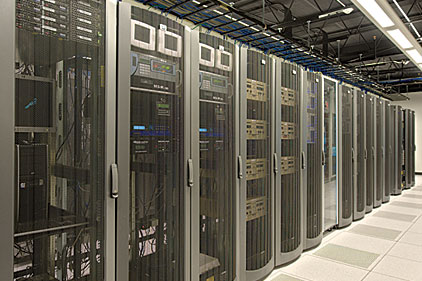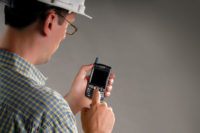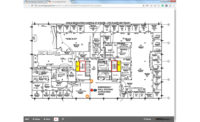More than half (56 percent) of Americans have smartphones today, according to the Pew Internet & American Life Project. And that number most likely is higher among people who have security systems. As smartphones have proliferated, the security industry is finding more ways for people to use their wireless devices to interact with their security systems — from receiving alerts when their systems are disarmed, to turning up the thermostat while on the ride home in a car.
Central stations often play a key role in supporting capabilities such as these. There are three basic ways they can get involved including reselling manufacturer-provided options, using functionality available through their automation software, and developing their own mobility applications.
Manufacturers Offer a ‘Cloud’ Approach
The manufacturer-provided approach to mobility is sometimes called a “cloud” approach. Several manufacturers have created smartphone apps that interact with server farms operated by the manufacturers that are also known as the “cloud.” When a homeowner uses an app to, for example, adjust a thermostat in his home, a signal is sent from the smartphone to the manufacturer’s server farm, and the servers then send the command to the control panel in the home.
The apps that support this approach typically are available at no charge through Apple and Android online stores. Manufacturers receive a monthly fee for providing the services, but dealers charge a higher monthly fee to their customers, making this a profitable source of recurring monthly revenue (RMR) for the dealers.
Warrendale, Pa.-based Guardian Protection Services has partnered with a range of manufacturers to support mobility services. The company offers the mobility services to its own end user customers, and supports companies in its dealer network that sell the services to their customers.
“These services provide the ability to arm and disarm security systems, control HVAC and lighting, can lock and unlock doors and view activity via cameras, among other things,” comments Jim Breisinger, vice president of information technology for Guardian Protection Services.
Some cloud-based mobility services also support video capability, enabling customers to “peek in” on babysitters, housekeepers, etc. Breisinger notes that these offerings also provide the ability to automatically send short clips to the customer when motion is sensed or when the system is armed or disarmed. Those clips are stored in the cloud, he explains.
According to Breisinger, however, customers are not fully satisfied with these offerings because they would like to see images from video cameras continuously recorded and stored for a specific period of time so that they can review the images if needed. Some providers of cloud-based mobility services are working on adding this capability, Breisinger says. An alternative is to use a video camera with built-in storage capability, he explains. Until now, such cameras have been cost-prohibitive for most residential users, but he expects to see lower-cost models with storage capability available soon.
How Central Stations Support Cloud Offerings
Depending on the manufacturer, alarm signals and other signals requiring the attention of a central station operator may be sent first from the panel to the cloud and from there to the central station. Depending on how the account is set up, the signals also may be directed to the homeowner’s smartphone.
Alternatively, some manufacturers’ panels send alarm signals directly to the central station, while simultaneously sending the signal to the cloud, which will push it out to the customer, if appropriate.
An important capability for manufacturer-provided mobility services is to use a control panel that uses either a broadband Internet or cellular data connection for communications. That means central stations wanting to support such offerings may need to invest in new central station receivers to support those panels.
“We had to invest in IP receivers to receive traffic driven through our partners,” Breisinger observes.
Another role that central stations should be prepared to play to support manufacturer-provided mobility capabilities is billing. Manufacturers typically do not bill end users. Instead, they bill through central stations. Dealers with their own central stations get a bill from the manufacturer and must handle billing to end users. Third-party central stations bill their dealers, who bill end users.
Some central station executives say that setting up to bill for cloud-based services requires some work. “It was challenging to appropriately bill without creating administrative overhead,” comments David Avritt, president of Pensacola, Fla.-based third-party central station SentryNet. SentryNet’s solution was to use on-staff programmers to create software to automate that task.
Another third-party central station executive notes that companies like his are not going to get rich from this type of service. “The central station gets a very small part,” comments Kevin McCarthy, national sales manager for Des Plaines, Ill.-based EMERgency24.
He and other central station executives noted, however, that they have to support manufacturers’ mobility apps to remain competitive. They also noted that their dealers look to them for information about manufacturer apps, requiring them to keep close track of changes to manufacturers’ offerings.
Overall, however, most of the executives SDM spoke to for this article agreed that manufacturers play an important role in enabling small and medium-size dealers to remain competitive.
“If you’re not a big company, it’s pretty hard to develop something that has the same features,” Breisinger comments. “It’s not only expensive to build but also to maintain.”
He notes, for example, that additional work would be required every time a new panel came on the market. He argues that manufacturer-provided options are a great alternative to taking on that work. “When you have a best-in-class partner there’s no quicker way to market or better way to stay relevant,” he believes.
Central Station Automation Software’s Role
Another way central stations can easily offer mobility capabilities is to use functionality built into their central station automation software. Software from several manufacturers can automatically send email or text messages to customers’ smartphones in the event of an alarm — and if the central station logs openings and closings for the customer, that information also can be pushed out.
Steve Ipson, director of business development for Moonachie, N.J.-based third-party central station Monitor America, notes that the automation software his company uses can be configured to automatically push video clips out to customers who use the central station for video monitoring. In addition, some central station software providers offer Web portals that end users can use to view their alarm history.
The mobility capabilities built into central station automation software seldom, if ever, are based on smartphone apps and cannot provide certain functionality such as the ability to control thermostats. Unlike with manufacturer-provided mobility capabilities, however, dealers don’t have to pay a monthly fee to use the capabilities built into central station automation software. Accordingly, central stations SDM spoke with said they do not charge customers for these capabilities.
Another advantage of using mobility capabilities delivered through automation software is that end users don’t have to have an IP or digital cellular connection to the security system. As long as homeowners have smartphones, the central station can push alerts to them — even for panels that use a digital dialer and traditional phone line for communications.
Central Station-Created Options
Some central stations have programmers on staff and have used those people to create their own Web portals that technicians can use from their smartphones in order to put an account on test or check alarm history, for example. Programmers for some other central stations have created their own smartphone apps to provide that functionality — and central stations offering these apps say they are very popular.
Several central stations, including SentryNet, also make their internally developed portals or apps available to end users, giving them the same functionality provided to technicians but for their own account only. SentryNet also is working on adding a new capability for its consumer app so that dealers will be able to push out quarterly notifications to their customers asking them, for example, to update their call list. The central station will be able to use push capability to advise end users when a central station operator has reached out to the end user’s contact list in response to an alarm signal.
It’s difficult for an app developed by a central station to provide the same functionality as manufacturer-provided apps because some functions require the ability to send commands to the control panel. Examples of functions that are difficult for central-station developed software to support include disarming the system and changing a thermostat.
One third-party central station that has found a way to support such functionality, however, is Syracuse, N.Y.-based Rapid Response Monitoring Services.
“Many panel manufacturers have provided open solutions to remote control of the systems,” explains Morgan Hertel, vice president of operations for Rapid Response. In addition, he notes that there are some “universal methods” of controlling alarm equipment such as keyswitch inputs, universal keypad bus adapters, and serial connections to panels.
Another form of control, he notes, is Z-Wave. “There are dozens of Z-Wave thermostats and hundreds of Z-Wave controllers,” he observes. “All of these are easily controlled by external applications.”
Using methods such as these, Rapid Response has developed a smartphone app that can arm and disarm a system and control functionality such as lights and thermostats. Because these capabilities match what various manufacturers offer for a monthly fee, Rapid Response is able to generate RMR from these mobility services. Rapid Response offers its app to its dealers as a “brandable” option, Hertel notes.
PERS Goes Mobile
Some central stations are beginning to offer monitoring services that take advantage of the global positioning capability built into today’s smartphones. Some of these offerings take the functionality of a personal emergency response system (PERS) and make it mobile. Those offerings are sometimes known as MPERS for mobile personal emergency response system.
With MPERS, a smartphone app gives the end user a panic button that he or she can activate to summon help from the central station if, for example, she were accosted. Potentially she also could use the camera functionality of the smartphone to capture video of the perpetrator and send it to the central station.
“We think this will play well in the marketplace,” comments Michael Joseph, vice president and general manager for Anaheim, Calif.-based Mace CSSS, a central station serving a dealer network that is exploring the possibility of offering MPERS.
Joseph believes Mace is ideally positioned to offer MPERS because in addition to operating the central station, its parent company has a separate business that sells the well-known self-defense spray by the same name. The parent company sees synergies between the spray and MPERS because both involve personal protection.
“We call it Mace end-to-end or Mace 360,” Joseph comments.
Mace is in the process of determining the best way to offer MPERS, Joseph explains. He notes that some vendors operate their own server banks, enabling them to store video, while others are looking to avoid that investment by collaborating with central stations that would own and operate the servers.
Mace also is trying to determine the best way to open an audio channel between the central station and the customer, Joseph notes.
Ed Bonifas, vice president of Aurora, Ill.-based security dealer Alarm Detection Systems, notes another issue involving MPERS. “It’s a challenge to monitor,” Bonifas observes. Unlike with home-based PERS, he notes, “you have to call the police department where the phone is.”
Other apps that can leverage smartphone GPS capability include geo-fencing, which sends an alert when an employee or teenager (or more precisely the person’s smartphone) goes outside of a specified area. Some cloud-based mobility services support this capability, observes Breisinger, of Guardian Protection Services.
Breisinger expresses concern about such offerings, however. “The problem there is battery life,” he says, explaining that GPS-based services deplete the smartphone battery quickly.
Smartphone manufacturers continue to make progress on battery life, however, so that concern may be less of an issue in the future. Considering that all of the GPS-based options can command additional recurring monthly revenue, it’s likely that we will see more security companies offering these capabilities in the future.






